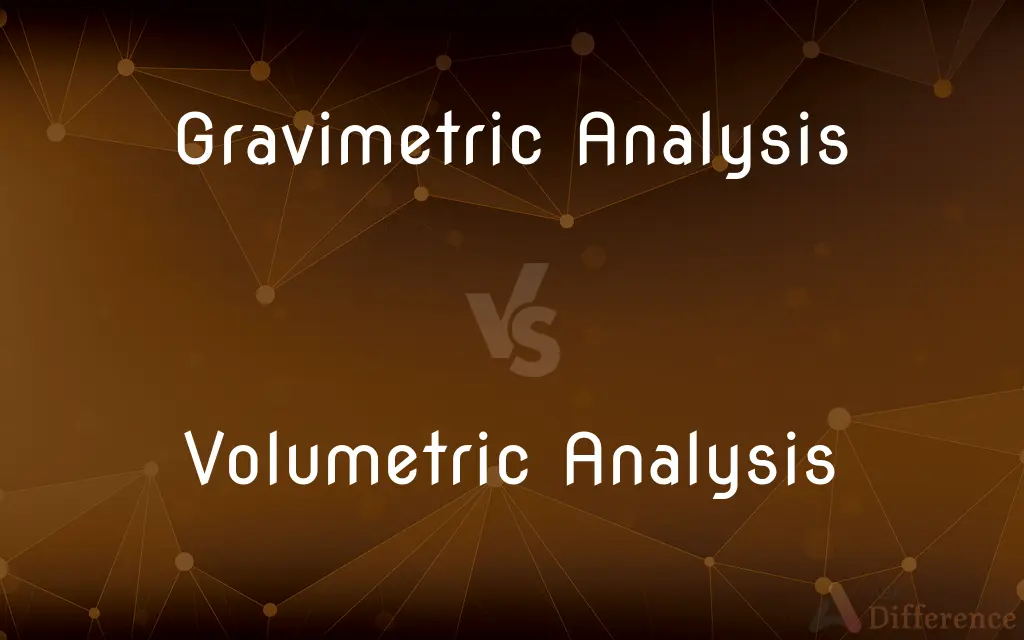Gravimetric Analysis vs. Volumetric Analysis — What's the Difference?
Edited by Tayyaba Rehman — By Fiza Rafique — Published on December 6, 2023
Gravimetric Analysis measures mass, while Volumetric Analysis measures volume for quantitative analysis.

Difference Between Gravimetric Analysis and Volumetric Analysis
Table of Contents
ADVERTISEMENT
Key Differences
Gravimetric Analysis refers to a quantitative method in which the amount of an analyte is determined based on its mass. On the other hand, Volumetric Analysis involves determining the quantity of an analyte by measuring its volume. These techniques help in accurately identifying the composition of a given sample.
In Gravimetric Analysis, the target substance is isolated from the original sample by a series of chemical or physical changes, and its mass is determined. This can be achieved through processes like precipitation, filtration, drying, or ignition. In contrast, Volumetric Analysis requires one to measure the volume of a solution (often a titrant) that reacts with the analyte in a chemical reaction, to deduce its concentration.
A notable aspect of Gravimetric Analysis is its emphasis on the accurate measurement of mass. This technique is highly precise, especially when conducted carefully to avoid potential errors. Volumetric Analysis, meanwhile, places importance on the accurate measurement of volume, using instruments like burettes or pipettes to ensure precision.
Gravimetric Analysis may be seen as a time-consuming method, especially due to the multiple steps involved, such as drying and weighing the sample multiple times. Volumetric Analysis, on the other hand, can often be faster, particularly when automated equipment is used. Yet, the speed of the latter can sometimes come at the cost of precision, especially if there are errors in calibration or measurements.
An advantage of Gravimetric Analysis is that it can offer high precision and is less susceptible to interference from other ions present in the sample. However, Volumetric Analysis, due to its straightforward nature, is commonly employed in routine laboratory analyses and often requires less sophisticated equipment.
ADVERTISEMENT
Comparison Chart
Measurement Basis
Mass
Volume
Main Procedure
Precipitation, drying, weighing
Titration
Precision
High, with careful execution
May vary with equipment calibration
Time Consumption
Can be time-consuming
Often faster
Equipment Sophistication
May require advanced setups
Less sophisticated equipment
Compare with Definitions
Gravimetric Analysis
Emphasizes accurate mass measurement.
For exact mass determinations, they relied on Gravimetric Analysis.
Volumetric Analysis
Determines analyte concentration via volume measurement.
The Volumetric Analysis revealed the acid's concentration.
Gravimetric Analysis
Quantitative method based on mass.
The purity was confirmed using Gravimetric Analysis.
Volumetric Analysis
Commonly employs titration as a method.
They conducted a Volumetric Analysis to find the endpoint of the reaction.
Gravimetric Analysis
Known for high precision with careful handling.
They chose Gravimetric Analysis for its unmatched precision.
Volumetric Analysis
Relies on accurate volume measurements.
Accurate pipetting is essential for Volumetric Analysis.
Gravimetric Analysis
Technique requiring isolation and weighing.
Using Gravimetric Analysis, they isolated and weighed the precipitate.
Volumetric Analysis
Quantitative technique based on volume.
The lab primarily uses Volumetric Analysis for routine tests.
Gravimetric Analysis
Involves determining analyte via its weight.
The Gravimetric Analysis provided insights into the compound's concentration.
Volumetric Analysis
Often used for routine laboratory tests.
For daily samples, they prefer Volumetric Analysis.
Common Curiosities
Is Gravimetric Analysis precise?
Yes, Gravimetric Analysis is highly precise when conducted carefully.
What's a primary procedure in Volumetric Analysis?
Titration is a primary procedure in Volumetric Analysis.
What is Gravimetric Analysis?
Gravimetric Analysis is a quantitative method that determines the amount of an analyte based on its mass.
What is vital for accuracy in Volumetric Analysis?
Accurate volume measurements are vital for accuracy in Volumetric Analysis.
Which method can be faster: Gravimetric or Volumetric Analysis?
Volumetric Analysis is often faster.
How is the analyte isolated in Gravimetric Analysis?
In Gravimetric Analysis, the analyte is isolated through processes like precipitation and drying.
Is Gravimetric Analysis time-consuming?
Gravimetric Analysis can be time-consuming due to multiple steps involved.
How does Volumetric Analysis differ from Gravimetric Analysis?
Volumetric Analysis determines the quantity of an analyte by measuring its volume, unlike Gravimetric Analysis which is based on mass.
Which method is commonly used for routine lab tests?
Volumetric Analysis is commonly used for routine laboratory tests.
Which analysis method focuses on mass?
Gravimetric Analysis focuses on mass.
Does Gravimetric Analysis require sophisticated equipment?
Gravimetric Analysis may require more advanced setups compared to Volumetric Analysis.
How is concentration deduced in Volumetric Analysis?
In Volumetric Analysis, concentration is deduced by measuring the volume of a solution that reacts with the analyte.
What ensures precision in Volumetric Analysis?
Proper equipment calibration and accurate volume measurements ensure precision in Volumetric Analysis.
Can Gravimetric Analysis detect interferences from other ions?
Gravimetric Analysis is less susceptible to interference from other ions.
Which analysis technique emphasizes weight for quantitative results?
Gravimetric Analysis emphasizes weight for quantitative results.
Share Your Discovery

Previous Comparison
LED Bulbs vs. CFL Bulbs
Next Comparison
UCSD vs. SDSUAuthor Spotlight
Written by
Fiza RafiqueFiza Rafique is a skilled content writer at AskDifference.com, where she meticulously refines and enhances written pieces. Drawing from her vast editorial expertise, Fiza ensures clarity, accuracy, and precision in every article. Passionate about language, she continually seeks to elevate the quality of content for readers worldwide.
Edited by
Tayyaba RehmanTayyaba Rehman is a distinguished writer, currently serving as a primary contributor to askdifference.com. As a researcher in semantics and etymology, Tayyaba's passion for the complexity of languages and their distinctions has found a perfect home on the platform. Tayyaba delves into the intricacies of language, distinguishing between commonly confused words and phrases, thereby providing clarity for readers worldwide.
















































